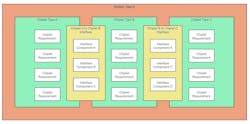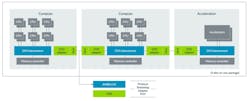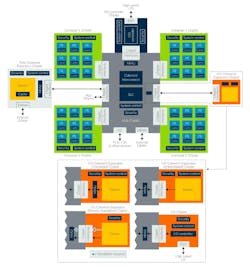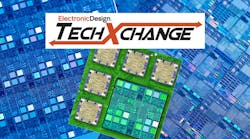Arming a Chiplet System Architecture
What you’ll learn:
- What is Arm’s Chiplet System Architecture (CSA)?
- How will this architecture enhance chip design?
Arm’s Chiplet System Architecture (CSA) is an ambitious project to help streamline the development of chiplet-based solutions. I talked with Eddie Ramirez, Vice President of Marketing at Arm, to get the lowdown on CSA (watch the video above).
Though the CSA Specification is still new, dozens of companies have signed on to utilize the specification. It will help in the construction of more complex chiplet-based solutions (Fig. 1). These advanced chip solutions are in high demand for various applications, from handling artificial-intelligence (AI) chores in the data center to providing the computational support needed for self-driving cars.
The details continue to be worked out, but it builds on Arm’s components like the Arm Neoverse Compute Subsystem (CSS) and, of course, Advanced Microcontroller Bus Architecture (AMBA), Arm’s standard for connecting functional blocks.
AMBA has been used for interconnects on monolithic die for a long time. The AMBA specification includes AMBA Coherent Hub Interface (CHI) and AXI. CHI Chip to Chip (C2C) is an extension that targets chiplets (Fig. 2). CHI provides a full cache-coherency model.
The CHI protocol has been around for a decade with enhancements along the way. It provides features like atomic and exclusive transactions, Distributed Virtual Memory (DVM) management, and realm management. CHI has parity protection plus support for write zero, data elision, and copy-at-home for reducing data transport.
CSA is meant for complex designs (Fig. 3), leveraging a hub-based approach with clear definitions of standard functional interfaces like memory controllers. The specification details interfaces and functional descriptions for all of the major components from direct memory access (DMA) to interrupts to memory and cache control.
AMBA and CHI are open standards. While Arm is building their IP around these, it’s not just a specification that requires Arm IP. Processing cores could easily incorporate other architectures like RISC-V.
One might think that standards like Universal Chiplet Interconnect Express (UCIe) may not be needed now, but a closer look at CSA reveals it’s built on other standards like UCIe. CSA is another step toward standardization of chiplet-based designs that should lead to more chiplets and faster chip creation.
>>Check out this TechXchange for similar articles and videos
About the Author
William G. Wong
Senior Content Director - Electronic Design and Microwaves & RF
I am Editor of Electronic Design focusing on embedded, software, and systems. As Senior Content Director, I also manage Microwaves & RF and I work with a great team of editors to provide engineers, programmers, developers and technical managers with interesting and useful articles and videos on a regular basis. Check out our free newsletters to see the latest content.
You can send press releases for new products for possible coverage on the website. I am also interested in receiving contributed articles for publishing on our website. Use our template and send to me along with a signed release form.
Check out my blog, AltEmbedded on Electronic Design, as well as his latest articles on this site that are listed below.
You can visit my social media via these links:
- AltEmbedded on Electronic Design
- Bill Wong on Facebook
- @AltEmbedded on Twitter
- Bill Wong on LinkedIn
I earned a Bachelor of Electrical Engineering at the Georgia Institute of Technology and a Masters in Computer Science from Rutgers University. I still do a bit of programming using everything from C and C++ to Rust and Ada/SPARK. I do a bit of PHP programming for Drupal websites. I have posted a few Drupal modules.
I still get a hand on software and electronic hardware. Some of this can be found on our Kit Close-Up video series. You can also see me on many of our TechXchange Talk videos. I am interested in a range of projects from robotics to artificial intelligence.




